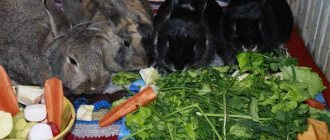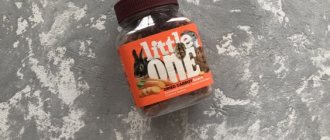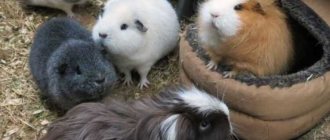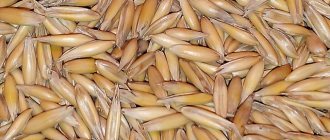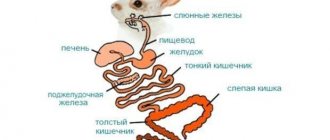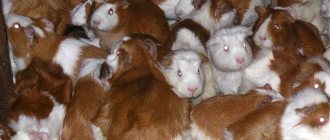Rabbits are exclusively herbivorous mammals. Therefore, their diet should consist of useful vegetation as much as possible. The green “menu” should be given special attention. Not all plants are useful, and some can simply lead to the death of animals. Therefore, rabbit breeders should be well acquainted with which greens are acceptable and which ones should not be fed to their pets.
What grass can rabbits eat?
To properly feed rabbits, it is necessary to use green grass, leaves and fresh tree shoots throughout the entire season - from early spring to late autumn. Summer is the ideal time to fully feed these animals.
During this period, you can find a sufficient number of different herbs both in forests, meadows and fields, and in your own gardens. This approach also has an economic basis, since it allows you to reduce the amount of grain feed, and therefore products from rabbits will cost much less.
Rabbits should be fed green food from early spring to late autumn. Numerous herbs contain nutritional components and vitamins, and also have medicinal effects. Grass for rabbits has a beneficial effect on the functioning of the digestive system, improves the quality of the coat and accelerates the growth of the animal.
Rodents, which include rabbits, best absorb and digest grain feed. It contains all the components necessary for life and growth:
Other wild crops
In addition to the plants described above, rabbits love the following grass fresh in summer and dried in winter:
- clover (wild clover);
- shiritsa;
- veres;
- carrot;
- sweet clover;
- sorrel (horse sorrel);
- yarrow;
- mouse peas;
- quinoa;
- American;
- whine;
- common thyme (thymus vulgaris);
- sow thistle;
- shepherd's purse;
- burdock.
Almost all of them have healing properties and have a beneficial effect on the functioning of the digestive system, promoting the full growth and development of both young animals and adults.
():
It should be remembered that grasses are, first and foremost, food for rabbits. If there is any pathology, plants cannot cure the problem. The healing properties of various crops will promote recovery, but will not replace full treatment.
Beneficial properties of herbs
Grasses appear in early spring and disappear in late autumn with the first frost. The benefits of green feed are quite great:
- They are well digested and quickly absorbed by rabbit stomachs.
- The fiber found in greens (especially those mowed late) has a beneficial effect on the digestive system of domestic herbivores.
- The growth of animals is stimulated.
- Fresh grass is a source of vitamins and nutritional components for rabbits.
- The quality of their wool improves.
Properly selected herbal food strengthens the pet’s immunity and promotes the growth and development of young animals. The consumption of certain types of herbal plants nourishes the animal’s body with various substances and elements necessary for its health, which include:
- vitamins;
- minerals;
- proteins.
Also, decorative rabbits can be given various salads, except lettuce. We also recommend watching a video that tells you how to grow grass for your pet rabbit in winter (in a tray on the windowsill).
Tip: Using green herbs to feed rabbits, you can reduce the amount of grains and feed in the diet by half. This will have a positive impact on the cost of the resulting meat, fluff and fur skins.
The table discusses what herbs can be fed to rabbits without fear for their health, and also notes the nuances of their preparation.
| Herb name | Beneficial features | Secrets of collection and preparation |
| Dandelion officinalis |
| Dandelions are best given in combination with other herbs, but not more than 30% of the total. Exceeding the volume of feeding dandelions to rabbits leads to growth retardation. |
| Siberian hogweed |
| Grows in forest clearings between bushes. It begins to bloom in June-July. Only leaves are used as food for rabbits. |
| Nettle |
| Nettles are given fresh (without flowers) and stored for the winter. When used as green mass, leaves and stems are scalded with boiling water, crushed and added to dry food. Nettle hay is fed to pregnant females in the spring. Nettle leaves collected in late June - early July have a medicinal effect. |
| Coltsfoot |
| Coltsfoot plants begin to produce green mass from mid-May. Harvesting for the winter begins in June. Leaves, flowers and roots are dried. |
| Wheatgrass |
| Leek rhizomes are used as feed, which must be thoroughly washed. Dried rhizomes are stored in a jar for 2-3 years. |
| Plantain |
| Grows on roadsides, in meadows and field boundaries. |
| Sagebrush |
| In the fall, by eating wormwood, rabbits cleanse their bodies of worms. Consumption of a large amount of wormwood (with its share in the feed structure of more than 40%) causes nervous excitement in rabbits. |
How to make the right choice
However, you should not think that all herbs are equally useful; when choosing, it is very important not to make a mistake, otherwise you can greatly harm the animal’s body.
Thus, seeded species, in particular alfalfa, lipin, can be used as feed. However, this method of feeding cannot be called economical, but for the sake of economy, you need to use wild plants; they grow in large quantities in meadows, forests, fields, and what have you to speak, even in most vegetable gardens. You should also know that green herbs perfectly compensate for grain feed and compound feed. This is very important when taking into account the cost of meat and fur.
Now it is very important to understand (especially for novice rabbit breeders) what kind of grass can be fed to long-eared pets. It is preferable to feed grass that is still young, since it contains a large amount of protein, but little fiber.
If you use plants that are already in the last stages of growth for food, then you need to take into account that most of the nutrients are no longer in them, but on the contrary, there is an order of magnitude more fiber there, and this is the reason for poor digestion.
Animals, like people, need variety in their diet, so you shouldn’t feed them the same grass for a long time. Varied green food is consumed by the animals with great eagerness. If the grass has just been mowed and there are still traces of morning dew on it, then you don’t need to give it to the animals right away, it’s better to dry it slightly, this way it will be much better absorbed by the rabbit’s body.
Attention - dangerous herbs!
Eating some herbs in your rabbit's diet can be detrimental to your pets if you don't know which ones are dangerous or poisonous. In addition to edible herbs, quite a large number of dangerous plants grow on lawns, parks, fields and forests. Here is a list of plants that should be avoided:
- Jasmine and poppy are ornamental herbs that cause various ailments.
- Buttercups. Disturbs the functioning of the stomach. Causes diarrhea, vomiting, excessive salivation. The stomach swells when poisoned.
- Euphorbia - it causes animals to vomit.
- Dream-grass. There is simply a full range of negative consequences - paralysis, convulsions, and interruptions in the functioning of the heart. Causes diarrhea and other intestinal disorders.
- Horned cornflower. Negatively affects the ventricles of rabbits. It causes both diarrhea and vomiting. If you eat too much of it, paralysis may occur.
- Datura. In addition to paralysis, it can cause interruptions in the functioning of the heart muscle.
- Veh is poisonous. It also causes anxiety and convulsions in animals, as well as paralysis of the respiratory tract.
- Hemlock. A very poisonous plant, from which the rabbits’ temperature drops, convulsions occur, and complete paralysis can occur.
- Swamp whitewing. It is found mainly in wetlands. When consumed as food, it causes bloating in animals, excessive salivation and general nervousness.
- Indoor plants such as begonia and azalea, amaryllis, etc.
- Great celandine. Weakens the body of animals, reduces appetite, makes them lethargic.
- Marigold. Causes rabbits to urinate frequently, causing colic and vomiting.
- Avran. Inflames the intestinal mucosa.
- Digitalis. It makes the animals’ hearts work faster, resulting in shortness of breath, arrhythmia, and convulsions.
- Frozen or canned green mass.
You should not feed animals greens collected from the sides of large and busy roads - the dust and exhaust gases they contain can lead to digestive disorders. As a last resort, it is necessary to thoroughly rinse such grass.
Poisonous plants
Not all grass can be beneficial for rabbits. Some representatives of the flora cause quite severe poisoning in eared pets, which can even lead to death. For rabbit breeders, the ability to identify plants so as not to harm their pets is very important.
It is known that such a simple procedure as drying can reduce the toxicity of some herbs or completely neutralize them. But at the same time, there are greens that, when dried, on the contrary, accumulate dangerous toxins. But some green seedlings, when ensiled, become deadly poisons for fluffies.
| The most poisonous plants | |
| Buttercup | It is especially dangerous when fresh. Causes severe diarrhea, bloating, food poisoning. When dried it becomes less dangerous. |
| Lumbago (Sleep-grass) | Poisoning accompanied by convulsions or paralysis. When dried, it almost completely loses its toxic properties. |
| Wolfsbane (Wrestler) | A particularly poisonous species of buttercup. Causes poisoning, which ends in death. Equally dangerous in fresh and dried form. |
| White hellebore | Diarrhea, bloating, difficulty breathing, up to the death of the animal. |
| Colchicum (Colchicum) | Poisoning with fatal outcome. |
| Great celandine | Diarrhea, bloating, convulsions, possible death of the animal. |
| Less poisonous herbs May cause symptoms of poisoning; eared animals should not be allowed to eat them. | |
| Datura common or stinking | |
| Wild mustard | |
| wild radish | |
| Avran officinalis | |
| Whitewing (Calla) | |
| Common cockle (Agrostemma) | |
| Juniper | |
| Astragalus | |
| Tobacco | |
| Nightshade | |
| Black Sea rhubarb | |
| Eggplant | |
Before mowing the grass, make sure that there are no plants in the area that are poisonous to rabbits.
| Plants that are less often fed to rabbits, but are also worth remembering about their toxicity: | • foxglove • castor bean • horsetail • hemlock • henbane • aloe vera • apple and pear seeds • almonds • macadamia nut • all parts of the apricot (except the fruit) • avocado • begonia • lupine • fern • bracken | • ivy • cloves • echinacea • dracaena • delphinium • ficus • yucca • kalanchoe • potato snowdrop • poppy • peony • oak leaves • valerian cornflower horned |
Basic feeding rules
First, you should understand what a novice rabbit breeder needs to know when supplementing the rabbits’ diet with green food. There are several fairly simple recommendations that are easy to remember and, at the same time, they will significantly increase the chances of raising healthy and strong individuals.
Like all pet food, the grass should be clean, free from rot or mold, and free of any chemicals. The younger the sprouts, the better - they have a large amount of proteins (proteins), but also some fiber.
These rules apply to almost all varieties of herbs and here are the feeding recommendations:
- Only young grass is given for food, since it contains more protein than fiber. And if you feed rabbits with late-harvested herbs, you may encounter problems digesting them.
- Include a variety of plant species in your diet as often as possible. This will have a beneficial effect on the general health of your pets.
- Wet and freshly cut grass, especially with dew, can lead to digestive upset.
- Herbs are harvested by hand and necessarily dried and dried. Plants mowed mechanically oxidize faster and can acquire toxic properties.
- Hay stored for the winter should not have rotten areas or contain mold.
- The feed should not be contaminated with dew, as it causes digestive problems. Animals are not allowed to eat fresh mass - it is first dried and withered.
- If you decide to feed plants after a long break, you should add feed gradually only after concentrated feed. This food is enriched with proteins, and their excess causes indigestion.
- The grass is harvested manually. Greens mowed by mechanical means acquire toxic qualities and oxidize faster.
- Do not collect herbs in areas where pets are walked, near busy highways, or near enterprises that work with hazardous substances. The same applies to grass from outdoor lawns;
- Legumes can cause bloating in rabbits, so they are introduced into the food gradually, preferably mixed with cereals.
Did you know? In Australia, wild rabbits are considered the worst enemies of the local population and agricultural enterprises. The country has introduced a ban on the breeding of these seemingly cute animals at the state level. Each violator faces a fine of 30 thousand US dollars. As it turned out, the mammals angered the aborigines with their rapid life activity, the annual losses from which are estimated at around 600 million US dollars.
What should not be in the diet: prohibited foods
Due to their undeveloped stomach muscles and very long intestines, rabbits must always be provided with sufficient food. Each new portion of food pushes what was previously eaten through the intestines. To avoid stagnation, the rabbit must constantly eat something. However, it is also impossible to overfeed animals, and if there is often food left in the feeders, then the amount of food consumed should be reduced.
Not all grass is good for rabbits.Rabbits have a very fast metabolism, so they eat a lot. But not every food is healthy. There are some foods that can be extremely dangerous for them. So what should you not feed rabbits? Let's try to figure it out.
Vegetables and fruits
Rabbits love succulent food, which includes vegetables and fruits. But they should not make up more than a third of the total daily diet. An excess of such feed can lead to bloating, disruption of the stomach and intestines, and in some cases, the death of the animal.
Be careful when feeding rabbits dried vegetables in winter. They swell in the stomach, which can lead to intestinal blockage.
Do not give boiled, fried or stewed vegetables to rabbits.
As for fruits, the choice is small. Rabbits can only be offered dried apples and pears, in small quantities and not often. Moreover, it is better to dry them yourself, after removing the core. Under no circumstances should rabbits be fed any exotic fruits.
You should not give fresh berries to rabbits, they cause fermentation in the intestines.
Plants
The rabbit's diet should contain three types of green food: medicinal herbs, meadow herbs and garden herbs. Freshly cut, wet grass should not be given. Eating wet grass can cause bloating and diarrhea. To avoid unpleasant consequences, it must be well dried and slightly wilted. To do this, fresh grass is left for several hours in a shady, well-ventilated place. If you cut the grass in dry weather, without dew or rain, then you can do without drying
It is important to know what grass you should not feed rabbits
Branches that are so necessary for healthy teeth and stomach must also be chosen with care. Animals should not be given branches of wild rosemary, apricot, bird cherry, wolf's bast and elderberry.
Limit the consumption of cherry and cherry branches.
Poisonous and dangerous plants:
- horse sorrel;
- aconite;
- quinoa;
- spurge;
- Melissa;
- wild radish;
- digitalis;
- lily of the valley;
- marsh horsetail;
- buttercup;
- sleep-grass;
- celandine;
- henbane;
- nightshade;
- hellebore;
- hemlock;
- lumbago;
- dope.
Milk products
Contrary to popular belief that milk protein is good for animals, this is not the case with rabbits. Only suckling babies need milk before and after vaccination. And for adult rabbits, milk, sour cream, cottage cheese and cheese are prohibited. Protein deficiency can be easily compensated with barley and dry yellow peas (in small quantities).
Legumes and grains
A significant part of a rabbit's diet consists of grain crops, and a slightly smaller portion of legumes. Under no circumstances should you give rice, sunflower seeds, millet, millet and rye. They will not bring any benefit. This is a very solid food containing little fibre. If rabbits eat little hay, which is placed in a cage (you can easily make one yourself), then it is good to add a small amount of bran to the food.
Hay should not contain many legumes.
From legumes you will have to exclude beans (red and black), beans and young peas. Such food is fraught with bloating and indigestion. Never give rabbits ready-made sweet cereals with milk and pea puree.
Sweets and baked goods
Sweet crackers, crackers, cookies, white bread, etc. are dangerous to the health of rabbits (regular and decorative). Furry pets can occasionally be pampered with special dry treats. For ordinary rabbits they are also prohibited. Excess salt, sugar and fat in food can lead to dire consequences.
The menu of decorative rabbits is not too different from the usual diet of meat rabbits. The list of prohibited foods can be supplemented with nuts, chips, ice cream, candy, sausage or meat and any cereal flakes. These products, which are extremely dangerous for them, can cause premature death for pets. Rabbits should not eat human food. Everything fatty, fried, spicy and smoked is excluded.
White fresh bread should not be given to rabbits.
Green food on your site
Experienced owners know what kind of grass can be fed to rabbits, and while weeding the beds, they set aside removed weeds, as well as thinned vegetable crops, and the remains of pruned branches of fruit trees. It can be:
- Nutritious legumes.
- Oats, which can actually be sown twice per season. To do this, the second batch must be planted immediately after the first mowing.
- Borage, which is very useful for those with long ears, requires deep planting.
- Green peas are used for food in the dried form of stems and pods.
Clover grows well and quickly after planting. Another plant for a summer cottage is considered cultivated alfalfa. Rabbits simply adore it, and it is easy to grow, since the crop can withstand any climatic conditions.
Important information
You can feed rabbits only young grasses that contain the greatest amount of useful and nutritious substances. They are easily absorbed by the gastrointestinal tract.
Plants that are harvested late for feeding have a high fiber content and take a long time to digest in the stomach.
It is not advisable to feed rabbits the same grass - a variety of greens will be many times more useful.
It is not recommended to feed domestic rodents with fresh, just mown grass or wet, after rain, washed with dew. This can lead to serious problems in the digestive system.
The cut green fodder is dried and only then given to the animals - this way it is better absorbed by the stomach.
Wet grass causes fermentation in the stomach. As a result, the rabbit experiences discomfort, bloating and general malaise. In addition, a humid environment is an excellent place for the development of pathogenic microorganisms. Eating such grass can cause severe poisoning.
It is forbidden to give yellow grass, which contains many carcinogenic substances.
Type of food
You should not feed your pet one specific type of grass for a long time. It is best to form a kind of herbal complex, collected from various species.
By using fresh grass feed, rabbit breeders must understand their benefits, and they are quite obvious:
- A minimum amount of money and time is spent on harvesting herbs.
- Savings on the purchase of dry food and grain crops due to the use of green mass.
- The stems and leaves of legumes contain many amino acids and proteins. And they contribute to the rapid growth and gain of live weight of animals.
In autumn and winter, there is a shortage of green grass. Therefore, many inexperienced rabbit breeders may immediately have a question: how to feed their pets grass? At this time, succulent food should be introduced into the diet, namely vegetables and silage (special canned food for rabbits). This type of food is easy to digest, it is quickly absorbed, and has a positive effect on digestive processes, as well as on lactation.
Closer to spring, hay reserves usually come to an end; for this period it is necessary to prepare branch feed. To do this, at the beginning of summer, young branches are cut from various deciduous trees, tied into brooms and dried in a ventilated room.
You can include the following succulent foods in your eared menu:
- red and yellow carrots. This vegetable is an essential source of carotene, vitamins B and C, all of these components are necessary for the body of rabbits in the winter;
- fodder cabbage. The vegetable contains a high level of vitamin K, protein, as well as mineral elements - calcium, sulfur, phosphorus, iron;
- You can give beets fresh or dried. Sugar beets are well digestible. But this vegetable crop should be given in limited quantities;
- Sometimes rabbits can be fed potatoes. But since it contains a high level of starch, it is recommended to boil the vegetable;
- Be sure to additionally feed the animals with pumpkin, watermelon, and zucchini.
Rabbits are very fond of raspberry and linden, alder and rowan branches. Plants such as apricot, buckthorn, elderberry and bird cherry cannot be used. The branches of these trees contain toxic substances and can harm your pet.
You can give your rabbit branches from the following trees:
- Maple
- Apple tree
- Rowan
- Ash
- Mulberry
- Grape
- Acacia
- Raspberries
Sometimes you can feed branches:
- Duba
- Birches
- Alders
- And you
- Coniferous trees
In the spring-summer season, when forbs are rampant, green matter in the rabbits' diet half replaces feed and cereals.
Apples
Apples are one of the most common crops on domestic farms, so farmers often use the fruits to feed eared animals. The healthy product is a good source of iron, which is responsible for the normal growth and development of animals. The juice remaining after squeezing is easily absorbed and does not cause digestive problems.
Apple slices are given to strengthen rabbit teeth. Thanks to the hard texture of the pulp, the oral cavity is cleansed of food debris. This becomes a prevention of various diseases that occur during rotting food.
What fruits can you feed your pets? There are a number of important requirements for the delicacy.
- Ripe. You should not give green waterfalls, which will cause digestive problems. It is recommended to feed the fruits in late summer and autumn.
- Homemade. Store-bought products are treated with special compounds, so they can be poisonous to the weak stomach of rabbits.
- Fresh. Never give out missing, rotten or moldy specimens. All affected areas are carefully removed.
Apples for rabbits
Apples are introduced into the diet of long-eared rabbits gradually, monitoring the body’s reaction. For the first time, you can give a small piece, and then increase the permissible dose. Even the largest fruit cannot replace good nutrition. One copy of the dessert is enough for an adult or a whole group of young animals.
In what form should apples not be used? Dried and heat-treated fruits are prohibited. The core of fresh products is removed along with the toxic pits.
